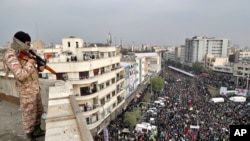Amnesty International has shared new details of how it developed an authoritative death toll for Iranians killed by their nation’s security forces in anti-government protests last month.
In a Monday statement, the London-based human rights group said it had received credible reports that at least 208 protesters were killed in less than a week of nationwide unrest that began Nov. 15. It was an increase of 57 from the group’s previous death toll reported on Friday.
“This alarming death toll is further evidence that Iran’s security forces went on a horrific killing spree,” Amnesty’s regional research director Philip Luther said in the statement. “Those responsible for this bloody clampdown on demonstrations must be held accountable for their actions.”
Speaking to VOA Persian on Monday, Amnesty Iran researcher Raha Bahreini said the killings were the deadliest in Iran since 1988. Human rights groups have said Iran's Islamist rulers secretly executed thousands of imprisoned political dissidents that year and buried them in unmarked mass graves. Iranian leaders have refused to acknowledge those killings ever since.
Iran’s government triggered the latest protests in dozens of cities by ordering a 50% increase in the subsidized price of gasoline, further straining the finances of Iranians struggling with high unemployment and inflation in a shrinking economy.
The government crushed the protests within days through a violent crackdown by security forces and by shutting off internet access nationwide for a week to stop protesters from sharing images and information with each other and the outside world.
Amnesty’s reported death tolls from Iran’s unrest have been widely quoted by Western news outlets, which have been unable to verify the killings due to Iranian restrictions on their access to the country. Iran’s weeklong internet outage made it even harder to assess the loss of life.
In remarks aired by Iranian state television on Tuesday, judiciary spokesman Gholamhossein Esmaili rejected death tolls reported by “hostile groups” as “utter lies,” without elaborating or offering official figures for killed and wounded protesters.
Iran has accused its foreign enemies and opposition exiles of inciting the protests, some of which involved people looting and setting fire to banks, gas stations and stores. It has said several security personnel were among the dead.
Amnesty’s statement said the group compiled its death tolls from reports whose credibility it ascertained by interviewing a “range of sources inside and outside Iran, including victims’ relatives, journalists and human rights activists involved in gathering the information.” It said it then cross-checked the information.
Mansoureh Mills, another Amnesty Iran researcher who spoke to VOA Persian, said it has taken days to verify the deaths of individual protesters, making it likely that the actual number of those killed is significantly higher than what the group has been able to confirm so far.
“We receive lots of information, sometimes from sources that we’re unfamiliar with,” Mills said. “We try to contact family members if we can, but it’s really difficult to speak to them, because mobile networks in some regions have not come back online, and a lot of people are scared to talk to us.”
In its statement, Amnesty said it learned that Iranian authorities have threatened victims’ family members, warning them not to speak to the media or to hold funeral ceremonies for their loved ones. It said authorities also have forced some families to make “extortionate payments” to have the bodies of their loved ones returned to them.
A Sunday report by The New York Times cited international rights organizations, Iranian opposition groups and local journalists as saying at least 180 to 450 people were killed in just four days of violence beginning Nov. 15. It said the Iranian government’s last violent crackdown on major national protests sparked by a disputed 2009 presidential election left 72 people dead over a much longer period of 10 months.
Amnesty’s statement said Iranian security forces killed people at a much more rapid rate in the latest unrest by shooting unarmed demonstrators in multiple locations, according to “extensive” video footage verified and analyzed by Amnesty’s Digital Verification Corps. It said dozens of protesters were shot dead in Tehran province’s Shahriar, one of the cities with the most fatalities.
“The use of firearms by security forces last month is unprecedented in the context of anti-government protests in Iran since the 1980s,” said Bahreini.
In an apparent response to those allegations, Iranian state television reported Tehran’s first acknowledgment that security forces had shot and killed people involved in the recent unrest. It described some of the dead as “rioters” armed with knives and firearms, and said they had taken people hostage in certain areas and attacked military bases in others. Iranian security personnel had “no choice but to confront them,” the TV report said.
Mills said Amnesty’s Digital Verification Corps determined that Iranian security forces had fired on unarmed demonstrators by analyzing dozens of video clips shared by social media users who labeled them as being part of last month’s protests. She said the verifications of the clips have been so precise that they provided her and other members of Amnesty’s Iran research team with the exact street names and dates of incidents in which the security forces used “excessive and lethal force” against protesters.
Amnesty researcher Sam Dubberly, who leads its digital verification team, told VOA Persian that it comprises around 80 to 120 students from universities in the U.S., Britain, Canada and South Africa. He said the student volunteers, who also have been analyzing footage from other hotspots of global unrest such as Iraq and Hong Kong, try to corroborate the information they glean from video clips with testimony from eye witnesses.
“We like to triangulate the evidence,” he said.
Mills said Amnesty plans to publish a full report on the protests next year.
This article originated in VOA’s Persian Service.








